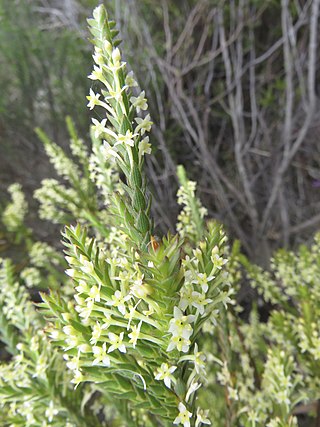
Nymphaea nouchali var. caerulea, is a water lily in the genus Nymphaea, a botanical variety of Nymphaea nouchali.

Chasmatophyllum is a genus of succulent plants native to the Karoo mountains of South Africa.

Cyrtanthus ventricosus, commonly called fire lilly, is a small deciduous, bulbous plant reaching a height of 100–250 mm (3.9–9.8 in). It is in the amaryllis family, Amaryllidaceae, and is found along the Cape Fold Mountains from the Cape Peninsula, Western Cape, to the Kouga Mountains, Eastern Cape in South Africa.

Struthiola striata is a rounded, heather-like shrub of up to 1.5 m (4.9 ft) high that is assigned to the Thymelaeaceae family. It has small assending leaves on long straight branches, with cream, soft yellow or pinkish flowers in spikes, each of which consist of a tube of about 1 cm (0.39 in) long with 4 oval sepal lobes and 4 yellow alternating petal-like scales. It is sometimes called ribbed capespray or featherhead in English and roemenaggie, katstertjie or veërtjie in Afrikaans. It grows on coastal flats and foothills in the Western Cape province of South Africa.

Lobostemon montanus, the turquoise bush bugloss, mountain lobostemon or agtdaegeneesbos, is a South African species belonging to the forget-me-not family.

Lobostemon belliformis, the Gouriqua lobostemon or beaut healthbush, is a critically endangered species in the forget-me-not family. It is known from a single locality on the Riversdale Plain in South Africa.
Juncus capillaceus is a rush species native to South America, but has been introduced to other parts of the world.
Diosma haelkraalensis, or Hagelkraal's diosma, is a rare species of plant from South Africa.
Euryops ursinoides is a highly endemic and vulnerable species from South Africa. It is in the daisy family.

Senecio malacitanus, also known as Senecio linifolius is a species of plant from South Africa.

Athanasia quinquedentata, or the fivetooth kanniedood, is a species of plant from South Africa.

Acrodon bellidiflorus, the common tiptoothfig, is a mesemb species from South Africa.
Acrodon deminutus, also known as the Malgas tiptoothfig, is a species of mesemb from South Africa.
Acrodon parvifolius, the Botriver tiptoothfig, is a species of mesemb from South Africa. This species, which grows close to the ground, can best be recognised by its small, thin leaves and its flowers, which form a dome in the middle.
Acrodon subulatus, the Overberg tiptoothfig, is a species of mesemb from South Africa.
Acrosanthes anceps is a species of plant from South Africa.
Isoetes stellenbossiensis, the Stellenosch quillwort or Cape Flats quillwort, is a species of plant from South Africa.
Cheiridopsis purpurea is a species of succulent plant from South Africa. It is found growing in the succulent Karoo vegetation type.
Cheiridopsis velox is a species of succulent plant from South Africa.
Cheiridopsis ponderosa is a species of succulent plant from South Africa.








